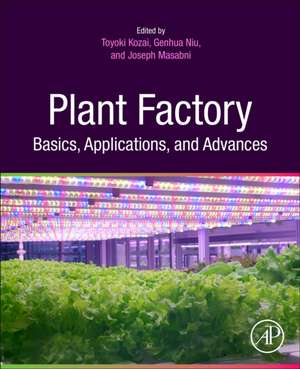Plant Factory Basics, Applications and Advances
Editat de Toyoki Kozai, Genhua Niu, Joseph G. Masabnien Limba Engleză Paperback – 18 noi 2021
The book is presented in four parts: Introduction, Basics, Applications, and Advanced Research. Part 1 covers why PFALs are necessary for urban areas, how they can contribute to the United Nations' Sustainable Development Goals, and a definition of PFAL in relation to the term "indoor vertical farm." Part 2 presents SI units and radiometric, photometric, and photonmetric quantities, types, components, and performance of LED luminaires, hydroponics and aquaponics, and plant responses to the growing environment in PFALs. Part 3 describes the indexes and definition of various productivity aspects of PFAL, provides comparisons of the productivity of the past and the present operation of any given PFALs, and compares PFALs with one another from the productivity standpoint by applying the common indexes. Part 4 describes the advances in lighting and their effects on plant growth, breeding of indoor and outdoor crops, production of fruiting vegetables and head vegetables, and concluding with a focus on a human-centered perspective of urban agriculture.
Providing real-world insights and experience, Plant Factory Basics, Applications, and Advances is the ideal resource for those seeking to take the next step in understanding and applying PFAL concepts.
- Provides the most in-depth assessment of PFAL available
- Compares PFAL to “indoor vertical farming and provides important insights into selecting optimal choice
- Presents insights to inspire design and management of the next generation of PFALs
Preț: 567.61 lei
Preț vechi: 768.87 lei
-26% Nou
Puncte Express: 851
Preț estimativ în valută:
108.62€ • 116.14$ • 90.56£
108.62€ • 116.14$ • 90.56£
Carte tipărită la comandă
Livrare economică 10-24 aprilie
Livrare express 12-18 martie pentru 81.32 lei
Preluare comenzi: 021 569.72.76
Specificații
ISBN-13: 9780323851527
ISBN-10: 0323851525
Pagini: 462
Ilustrații: 40 illustrations (20 in full color)
Dimensiuni: 191 x 235 x 25 mm
Greutate: 0.79 kg
Editura: ELSEVIER SCIENCE
ISBN-10: 0323851525
Pagini: 462
Ilustrații: 40 illustrations (20 in full color)
Dimensiuni: 191 x 235 x 25 mm
Greutate: 0.79 kg
Editura: ELSEVIER SCIENCE
Cuprins
PART 1. Introduction
1. Why plant factories with artificial lighting (PFALs) are necessary
2. Terms related to PFALs
3. Role and characteristics of PFALs
4. Contribution of PFALs to the Sustainable Development Goals (SDGs) and Beyond
PART 2. Basics
5. Photonmetric quantities and their application
6. LED product terminology and performance description of LED luminaires
7. Photon efficacy in horticulture: turning LED packages into LED luminaires
8. Balances and use efficiencies of CO2, water and energy
9. Hydroponics
10. Aquaponics
11. Plant responses to environments
PART 3. Applications
12. Productivity: Definition and application
13. How to integrate and optimize productivity
14. Emerging economics and profitability of PFALs
15. Business models and cost performance of downtown mini-plant factories
16. Indoor production of tomatoes
SECTION 4. Advanced Research in PFALs and Indoor Farms
17. Toward an optimal spectrum for photosynthesis and plant morphology in LED-based crop cultivation
18. Indoor lighting effects on plant nutritional compounds and mineral elements
19. Indoor Production of Ornamental Seedlings, Vegetable Transplants, and Microgreens
20. Molecular breeding of miraculin-accumulating tomatoes with suitable traits for cultivation in PFALs and the optimization of cultivation methods
21. Environmental control of PFAL
22. Human-Centered Perspective on Urban Agriculture
23. Towards commercial production of head vegetables in plant factories with artificial lighting (PFALs)
24. Concluding remarks
1. Why plant factories with artificial lighting (PFALs) are necessary
2. Terms related to PFALs
3. Role and characteristics of PFALs
4. Contribution of PFALs to the Sustainable Development Goals (SDGs) and Beyond
PART 2. Basics
5. Photonmetric quantities and their application
6. LED product terminology and performance description of LED luminaires
7. Photon efficacy in horticulture: turning LED packages into LED luminaires
8. Balances and use efficiencies of CO2, water and energy
9. Hydroponics
10. Aquaponics
11. Plant responses to environments
PART 3. Applications
12. Productivity: Definition and application
13. How to integrate and optimize productivity
14. Emerging economics and profitability of PFALs
15. Business models and cost performance of downtown mini-plant factories
16. Indoor production of tomatoes
SECTION 4. Advanced Research in PFALs and Indoor Farms
17. Toward an optimal spectrum for photosynthesis and plant morphology in LED-based crop cultivation
18. Indoor lighting effects on plant nutritional compounds and mineral elements
19. Indoor Production of Ornamental Seedlings, Vegetable Transplants, and Microgreens
20. Molecular breeding of miraculin-accumulating tomatoes with suitable traits for cultivation in PFALs and the optimization of cultivation methods
21. Environmental control of PFAL
22. Human-Centered Perspective on Urban Agriculture
23. Towards commercial production of head vegetables in plant factories with artificial lighting (PFALs)
24. Concluding remarks
